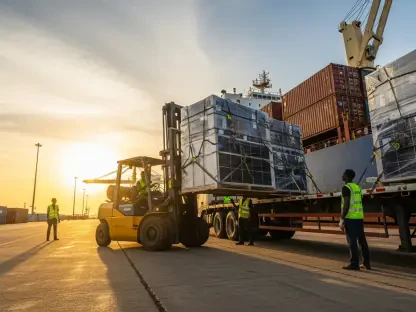The food and beverage (F&B) industry stands at a critical crossroads, as potential federal policy changes promise to reshape its landscape over the next four years. Influencing factors range from energy policies and deregulation to labor market changes, tariffs, and tax policies. Each of these areas carries significant implications, with the potential to drive major shifts in cost structures, operational practices, and overall strategies within the industry. As these changes unfold, adaptability and strategic planning will become pivotal for companies to navigate the evolving regulatory environment effectively.
Energy Policies and Implications
Domestic Energy Production and Costs
One of the central themes in the discussion of future energy policies is the potential impact on the F&B industry. President Trump’s pledge for U.S. “energy dominance” centers around ramping up domestic energy production through methods such as hydraulic fracturing, commonly known as fracking. This strategy aims to boost energy output significantly, leading to potential reductions in energy costs. The F&B sector, which relies heavily on energy for production and transportation, stands to benefit from these lower costs. Reduced energy expenses could pave the way for increased profitability, enabling companies to invest more in capital expansion and innovation.
However, the benefits of increased domestic energy production are not without uncertainties. Key among these is the status of energy credits provided under the Inflation Reduction Act (IRA). These credits, aimed at supporting clean energy investments, have played a significant role in encouraging manufacturers, including those in traditionally Republican states, to adopt more sustainable practices. With bipartisan support for these credits, their continuity remains a pivotal concern. The potential policy shift introduces an element of unpredictability that could affect future investments in clean energy initiatives.
Uncertainty of Energy Credits
The fate of the energy credits has broader implications beyond immediate cost savings. The IRA-backed credits have catalyzed various clean energy investments, driving manufacturers to adopt more environmentally friendly production methods. These credits have not only benefited individual companies but also contributed to a broader push towards sustainability within the industry. If these credits were to be discontinued, it could deter further investments in clean energy, potentially slowing down the industry’s progress towards reducing its carbon footprint.
Moreover, the bipartisan support for these credits adds another layer of complexity. While there is a general alignment on the benefits of clean energy investments, changes in administration and policy priorities could still affect the availability and structure of these credits. As such, the F&B industry must remain vigilant and adaptable, preparing for potential shifts that could impact their long-term sustainability goals. Companies may need to reassess their investment strategies and explore alternative avenues for achieving energy efficiency and sustainability in a potentially altered policy landscape.
Deregulation Prospects
Pro-Business Agenda and Regulatory Relaxation
A significant trend likely to continue under the new administration is deregulation, a shift that aligns with the pro-business agenda seen during Trump’s previous tenure. This agenda encompasses a range of regulatory relaxations across various sectors, including energy, Occupational Safety and Health Administration (OSHA) rules, Environmental Protection Agency (EPA) policies, and banking regulations. The withdrawal from the Paris Agreement serves as a prominent example of the administration’s stance against stringent environmental regulations. If similar deregulatory actions are pursued, the F&B industry could experience reduced compliance costs, enhancing operational efficiencies and easing access to capital.
The potential relaxation of emissions and banking regulations is particularly noteworthy. Reduced compliance burdens could lead to financial savings and operational flexibility. However, the extent of these benefits remains uncertain, as the balance between regulatory relaxation and environmental responsibility continues to be a contentious issue. While decreased regulation might boost short-term profitability for F&B companies, it also raises questions about long-term sustainability and environmental impact.
FDA Regulatory Proposals
Among the various agencies, the Food and Drug Administration (FDA) stands out as a key player in shaping the regulatory landscape for the F&B industry. The FDA’s recent actions, such as the ban on Red Dye #3, signal a commitment to addressing health concerns and ensuring consumer safety. Furthermore, the FDA is considering mandating nutritional information labels on the front of packaged foods. This proposal, aimed at informing consumers about saturated fat, sodium, and added sugar levels, reflects growing public interest in health and nutrition.
If implemented, the new labeling requirements would necessitate compliance within a few years, posing a significant challenge for companies. Most businesses would need to comply within three years, while smaller entities with annual sales under $10 million would have an additional year. This change underscores the FDA’s ongoing efforts to promote transparency and empower consumers to make informed choices. For the F&B industry, adapting to these new regulations will require investments in packaging redesigns, marketing strategies, and possibly reformulating products to meet consumer preferences for healthier options.
Labor Market and Immigration Policies
Impact of Immigration Policies on Labor Supply
Labor dynamics are a crucial aspect of the F&B industry, with potential policy shifts in immigration carrying significant implications. Stricter immigration controls or mass deportations could profoundly impact the availability of labor, particularly in agriculture and food production sectors already grappling with labor shortages. These manual jobs have historically struggled to attract the American workforce, relying heavily on immigrant labor. A reduction in this labor pool could result in increased labor costs and operational disruptions for businesses.
Addressing labor shortages poses a multifaceted challenge. One potential consequence of reduced immigrant labor is the increase in wages necessary to attract domestic workers. This could lead to higher production costs, which may eventually be passed on to consumers through increased product prices. Moreover, the availability of skilled labor remains a concern, as replacing experienced workers with new hires can affect productivity and operational efficiency. Navigating these labor market challenges requires thoughtful strategies that balance cost management and workforce sustainability.
Adoption of AI and Automation
In response to labor shortages and potential immigration policy changes, many F&B companies are turning to artificial intelligence (AI) and automation to enhance efficiency and maintain production levels. Automating repetitive tasks not only addresses labor gaps but also offers the potential to improve overall productivity. Technologies such as robotics, machine learning, and AI-driven process optimization are being integrated into various stages of production, from harvesting crops to packaging finished products.
The adoption of AI and automation brings both opportunities and challenges. On one hand, these technologies can mitigate the impact of labor shortages, ensuring continuity in production and enabling companies to scale operations more effectively. On the other hand, the transition to automated systems requires significant investments in technology, training, and infrastructure. Companies must weigh the short-term costs against the long-term benefits of increased automation. Additionally, the integration of AI and automation raises considerations around job displacement and the need for upskilling existing employees to work alongside advanced technologies.
Impact of Tariffs and Tax Policies
Tariffs and Their Economic Implications
Tariff policies represent another critical area of focus, particularly in light of the administration’s inclination towards imposing higher tariffs on imported goods. These tariffs aim to increase federal revenue and protect domestic industries by encouraging the purchase of locally produced goods. While such protectionist measures may initially seem beneficial for the F&B sector, there are potential downsides to consider. Higher import taxes could inadvertently raise costs for manufacturers that rely on imported raw materials and components, such as steel for equipment.
The economic implications of increased tariffs extend beyond direct cost increases. Higher tariffs can disrupt supply chains, leading to delays and additional expenses. Manufacturers may need to seek alternative suppliers, potentially at higher costs, to mitigate the impact of tariffs. Additionally, the protectionist stance could strain trade relationships with other countries, affecting the availability and pricing of essential inputs. The complexity of the global supply chain underscores the need for careful assessment and strategic planning to navigate the potential challenges posed by tariff policies.
Inflation and Consumer Spending
Tariffs are often associated with inflationary pressures, which could have a ripple effect on consumer behavior and spending patterns. As the cost of imported goods rises, manufacturers may pass these increases onto consumers in the form of higher prices for finished products. This, in turn, could lead to reduced consumer spending on certain F&B items, particularly non-essential products that are sensitive to price changes. The interplay between tariffs and inflation highlights the delicate balance that policymakers must strike to achieve economic objectives without adversely impacting consumer sentiment and industry revenues.
The long-term effects of tariff policies on the F&B industry remain an area of concern. While protectionist measures aim to bolster domestic production, the potential for increased inflation and its subsequent impact on both costs and consumer behavior is significant. Companies must closely monitor these developments and adopt strategies to mitigate the adverse effects of tariffs. This could involve diversifying supply chains, exploring alternative markets, and adopting cost-saving measures to maintain competitiveness in a dynamic trade environment.
Expiration of TCJA Provisions
The Tax Cuts and Jobs Act (TCJA) introduced several provisions that have influenced the financial landscape for the F&B industry. However, the impending expiration of certain TCJA provisions at the end of 2025 introduces further uncertainty. While the reduction of the federal corporate tax rate is a permanent change, many mid-size F&B companies structured as pass-through entities, such as S-corporations, partnerships, and limited liability companies, may face increased tax liabilities. These entities report earnings on individual tax returns, and the expiration of the TCJA’s reduced individual tax rates could result in higher taxes for many businesses.
The potential increase in tax liabilities calls for careful financial planning and strategic decision-making. Companies need to assess the long-term impact of these changes on their profitability and cash flow. The expiration of favorable tax rates could necessitate adjustments in financial strategies, including potential restructuring of business entities to optimize tax positions. Moreover, the dynamic nature of tax policies underscores the importance of staying informed and proactive in responding to legislative changes that could affect the industry’s financial landscape.
Phased Reduction in Bonus Depreciation
Another significant aspect of the TCJA is the provision for 100% expensing of certain business properties, known as bonus depreciation. This provision has allowed businesses to deduct the full cost of eligible property in the year it is placed in service, providing immediate tax benefits. However, the phase-down of bonus depreciation by 20% annually introduces a gradual reduction, with the percentage expected to decrease to 40% by 2025. This phased reduction impacts the timing of tax deductions for businesses, affecting their cash flow and financial planning.
The transition away from 100% expensing requires companies to reassess their capital investment strategies. The timing of investments and the anticipated future tax benefits must be carefully evaluated to optimize financial outcomes. As the bonus depreciation phase-down progresses, businesses may need to explore alternative tax planning strategies and leverage other available incentives. The evolving tax landscape underscores the need for strategic foresight and adaptability in managing the financial implications of these changes.
Navigating Uncertainty in the F&B Industry
The food and beverage (F&B) industry is at a pivotal point, as possible federal policy changes could significantly transform its landscape in the coming four years. These changes encompass a wide range of factors, including energy policies, deregulation, shifts in the labor market, tariffs, and tax policies. Each of these elements could have substantial repercussions, potentially leading to major alterations in cost structures, operational methods, and overall business strategies.
Energy policies, for instance, could either raise or lower production costs depending on the approach taken. Deregulation might result in reduced compliance costs but could also introduce fresh competitive challenges. Labor market changes could impact staffing costs and availability, affecting how companies manage their human resources. Tariff adjustments could influence the cost and availability of imported ingredients and products, while tax policy shifts might affect profitability and investment strategies.
As these developments unfold, companies in the F&B industry must prioritize adaptability and strategic planning. It will be crucial for businesses to stay informed about regulatory changes and anticipate their potential impacts. By doing so, they can effectively navigate the evolving landscape, ensuring they maintain competitiveness and profitability. The ability to anticipate and adjust to these changes will be vital for long-term success in the ever-changing regulatory environment.









